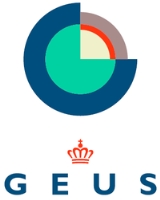
Geus
Encyclopedia
 |
|
| Established | June 14, 1995 |
| Activated | June 14, 1995 |
| Director | dr.phil. Martin Ghisler |
| Budget (2005) | 133 million DKK |
| Homepage | www.geus.dk |
| Employees | ~300 Staff and researchers |
GEUS is an abbreviation for Danmarks og Grønlands Geologiske Undersøgelse, the Danish
Denmark
Denmark is a Scandinavian country in Northern Europe. The countries of Denmark and Greenland, as well as the Faroe Islands, constitute the Kingdom of Denmark . It is the southernmost of the Nordic countries, southwest of Sweden and south of Norway, and bordered to the south by Germany. Denmark...
name for the independent sector research institute
Sector research institutes of Denmark
Sector research institutes of Denmark are state-owned independent research institutes under various Danish Government ministries, whose primary task is to do research in various fields...
under the Ministry of the Environment. The English name of this institute is Geological Survey of Denmark and Greenland, an advisory, research and survey institute in hydrogeology
Hydrogeology
Hydrogeology is the area of geology that deals with the distribution and movement of groundwater in the soil and rocks of the Earth's crust, . The term geohydrology is often used interchangeably...
, geophysics
Geophysics
Geophysics is the physics of the Earth and its environment in space; also the study of the Earth using quantitative physical methods. The term geophysics sometimes refers only to the geological applications: Earth's shape; its gravitational and magnetic fields; its internal structure and...
, geochemistry
Geochemistry
The field of geochemistry involves study of the chemical composition of the Earth and other planets, chemical processes and reactions that govern the composition of rocks, water, and soils, and the cycles of matter and energy that transport the Earth's chemical components in time and space, and...
, stratigraphy
Stratigraphy
Stratigraphy, a branch of geology, studies rock layers and layering . It is primarily used in the study of sedimentary and layered volcanic rocks....
, glaciology
Glaciology
Glaciology Glaciology Glaciology (from Middle French dialect (Franco-Provençal): glace, "ice"; or Latin: glacies, "frost, ice"; and Greek: λόγος, logos, "speech" lit...
, ore geology, marine geology
Marine geology
Marine geology or geological oceanography involves geophysical, geochemical, sedimentological and paleontological investigations of the ocean floor and coastal margins...
, mineralogy
Mineralogy
Mineralogy is the study of chemistry, crystal structure, and physical properties of minerals. Specific studies within mineralogy include the processes of mineral origin and formation, classification of minerals, their geographical distribution, as well as their utilization.-History:Early writing...
, climatology
Climatology
Climatology is the study of climate, scientifically defined as weather conditions averaged over a period of time, and is a branch of the atmospheric sciences...
, environmental history, air photo interpenetration
Interpenetration
Interpenetration may refer to:* Interpenetration , a term in Christian theology that refers to the mutual inter-penetration and indwelling within the threefold nature of the Trinity, God the Father, the Son and the Holy Spirit.* Interpenetration , a concept of Buddhist philosophy proposed in the...
, geothermic energy fields concerning Denmark
Denmark
Denmark is a Scandinavian country in Northern Europe. The countries of Denmark and Greenland, as well as the Faroe Islands, constitute the Kingdom of Denmark . It is the southernmost of the Nordic countries, southwest of Sweden and south of Norway, and bordered to the south by Germany. Denmark...
and Greenland
Greenland
Greenland is an autonomous country within the Kingdom of Denmark, located between the Arctic and Atlantic Oceans, east of the Canadian Arctic Archipelago. Though physiographically a part of the continent of North America, Greenland has been politically and culturally associated with Europe for...
.
GEUS works in close corporation with Geologisk Institut and Geologisk Museum, both part of University of Copenhagen
University of Copenhagen
The University of Copenhagen is the oldest and largest university and research institution in Denmark. Founded in 1479, it has more than 37,000 students, the majority of whom are female , and more than 7,000 employees. The university has several campuses located in and around Copenhagen, with the...
.
It publishes a service paper called Greenland Hydrocarbon Exploration Information Service (GHEXIS) and a newsletter called Greenland Mineral Exploration Newsletter (MINEX) in co-operation with the Bureau of Minerals and Petroleum (Råstofdirektoratet), a secretariat for the Joint Committee on Mineral Resources under Greenland’s home rule.
History
In 1888, "Danmarks Geologiske Undersøgelse" was created.In 1946, "Grønlands Geologiske Undersøgelse" was created.
On June 14, 1965, law no. 238 created GGU.
On December 23, 1987, law no. 864 merged GGU into DGU, changing its name to DGGU (Danmarks og Grønlands Geologiske Undersøgelse).
On June 14, 1995, Law no. 408 disbanded law no. 238.
On December 20, 1995, law no. 1076 concerning Danish sector research institutes created GEUS by merging DGU and GGU.
See also
- Geography of DenmarkGeography of DenmarkDenmark is located in Western Europe on the Jutland peninsula and several islands in the Baltic sea. It borders both the and the North Sea along its tidal shoreline , whereas the general coastline is much shorter, at , as it would, among other geographical features, not include most of the...
- Geography of GreenlandGeography of GreenlandGreenland is located between the Arctic Ocean and the North Atlantic Ocean, northeast of Canada and northwest of Iceland. Greenland has no land boundaries and 44,087 km of coastline. A sparse population is confined to small settlements along the coast. Greenland possesses the world's second...
- Gemstone industry in Greenland
External links
- Geological Survey of Denmark and Greenland, official website

